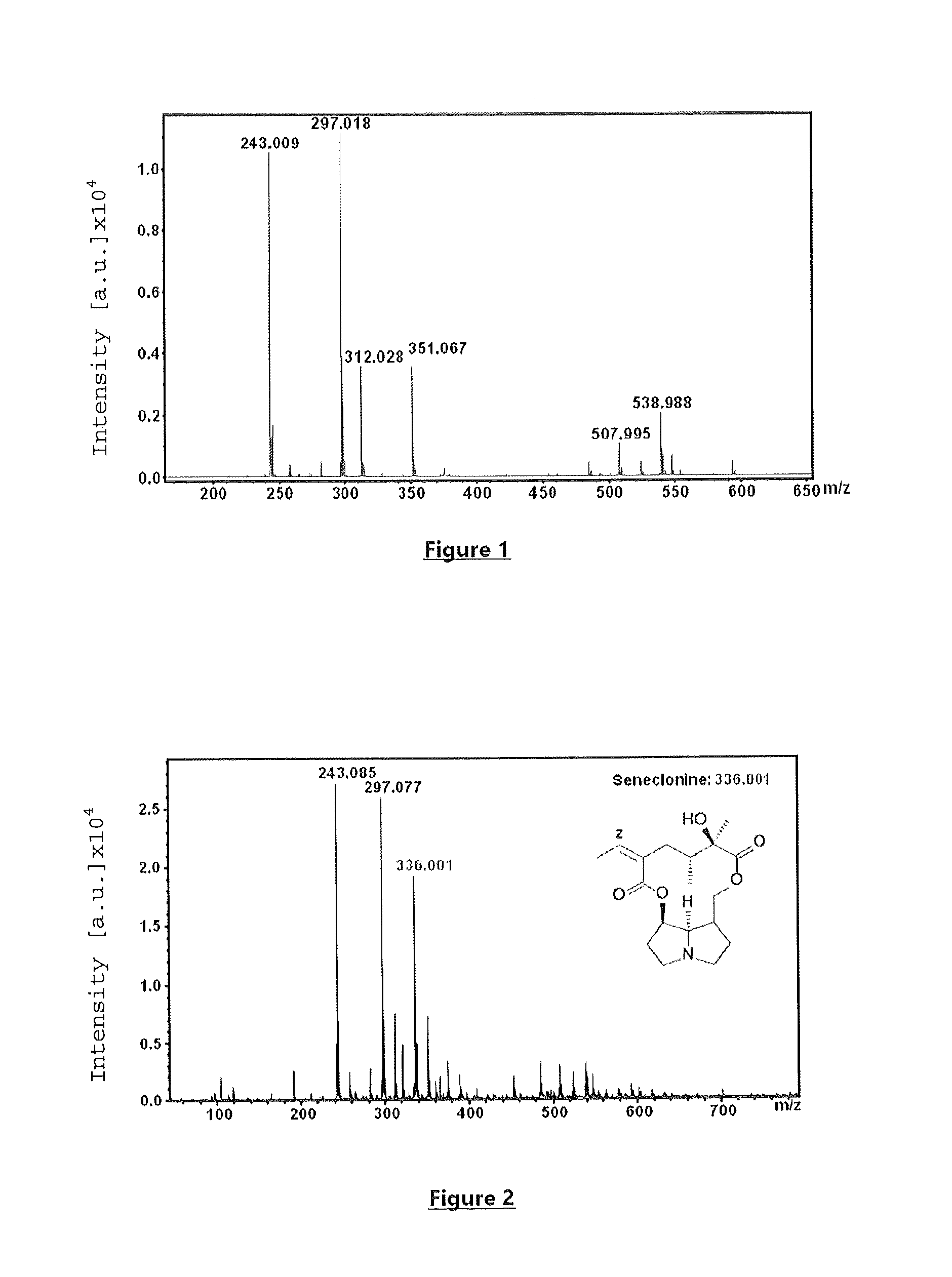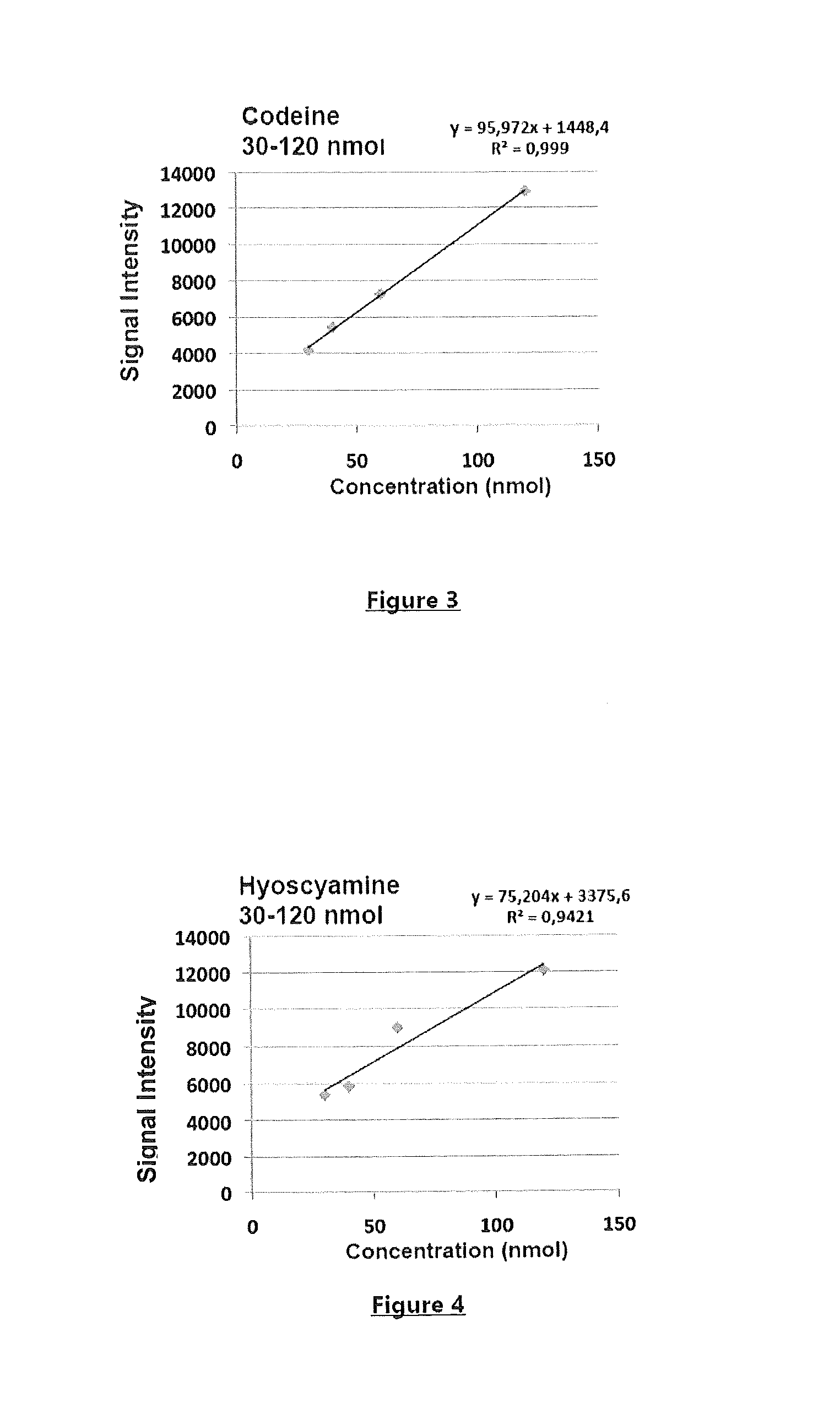New use for a compound as a matrix in the specific detection, identification and/or quantification of alkaloids by maldi-tof mass spectrometry
a mass spectrometry and compound technology, applied in the field of low-mass molecule analysis, can solve the problems of limiting technique, scattering in ion departure time, and inconvenient maldi-tof-ms method for analysis of molecules with low mass, and achieve high sensitivity and/or selectivity, and enhance the quantification of said small molecules
- Summary
- Abstract
- Description
- Claims
- Application Information
AI Technical Summary
Benefits of technology
Problems solved by technology
Method used
Image
Examples
example 1
Preparation of the MT3P (1) Matrix
[0116]The compound 3-(5-(5-(methylthio)thiophen-2-yl)thiophen-2-ylthio)-propanenitrile (1) or MT3P (1) below is prepared from 2-bromothiophene in three steps and with an overall yield of 80%, as shown according to scheme 2 below. The reaction conditions of this synthesis are as follows:[0117]for step i) magnesium, NidpppCl2, Et2O, reflux;[0118]for step ii) nBuLi, sulfur, and 2-bromopropionitrile, THF, room temperature;[0119]for step iii) cesium hydroxide and iodomethane, DMF / MeOH, room temperature.
The detail of these steps of this synthesis is described in the document Mass Spectrom., 2006; 41: 830-833.
example 2
Preparation of the Sample for Analysis
[0120]The analyte is dissolved in a suitable organic solvent (e.g. CH2Cl2, MeOH, etc.) at a concentration of 2.57 mmol / L. The solution prepared is stored at a temperature of −20° C. Prior to each experiment carried out in MALDI / TOF (Preparation of the matrix cocrystallized with the sample, as explained in the paragraph which follows), this solution is brought to room temperature and then diluted 1:3 in MeOH.
example 3
Preparation of the Matrix Cocrystallized with the Sample for Analysis
[0121]The cocrystallized matrix intended for use in a matrix-assisted laser desorption / ionization, or MALDI, mass spectrometry device, for a single analyte, is prepared as follows: One equivalent of analyte solution at a concentration of 0.861 mmol is mixed with two equivalents of matrix solution at a concentration of 33.67 mmol. The final concentrations are 0.287 mmol / L for the analyte and 11.22 mmol / L for the matrix. For a crude extract, for example, it is possible to mix one equivalent of crude extract (22 mg / mL) with two equivalents of concentrated matrix (30 mg / mL=0.1 mmol / mL).
PUM
| Property | Measurement | Unit |
|---|---|---|
| mass | aaaaa | aaaaa |
| temperature | aaaaa | aaaaa |
| volume | aaaaa | aaaaa |
Abstract
Description
Claims
Application Information
 Login to View More
Login to View More - R&D
- Intellectual Property
- Life Sciences
- Materials
- Tech Scout
- Unparalleled Data Quality
- Higher Quality Content
- 60% Fewer Hallucinations
Browse by: Latest US Patents, China's latest patents, Technical Efficacy Thesaurus, Application Domain, Technology Topic, Popular Technical Reports.
© 2025 PatSnap. All rights reserved.Legal|Privacy policy|Modern Slavery Act Transparency Statement|Sitemap|About US| Contact US: help@patsnap.com



